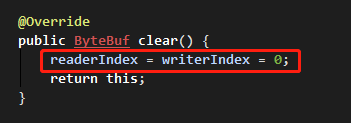Netty之緩衝區ByteBuf解讀(二)
阿新 • • 發佈:2020-03-18

> 上篇介紹了 ByteBuf 的簡單讀寫操作以及讀寫指標的基本介紹,本文繼續對 ByteBuf 的基本操作進行解讀。
# 讀寫指標回滾
這裡的 demo 例子還是使用上節使用的。
```java
ByteBuf buf = Unpooled.buffer(15);
String content = "ytao公眾號";
buf.writeBytes(content.getBytes());
System.out.println(String.format("\nwrite: ridx=%s widx=%s cap=%s", buf.readerIndex(), buf.writerIndex(), buf.capacity()));
byte[] dst = new byte[4];
buf.readBytes(dst);
System.out.println(String.format("\nread(4): ridx=%s widx=%s cap=%s", buf.readerIndex(), buf.writerIndex(), buf.capacity()));
```
進入 readBytes 方法,可以看到每次讀取的時候,指標是累加的,如圖:

但是,有時我們可能需要對當前操作進行回滾,讓指標回到之前的位置。這時,mark 和 reset 搭配使用,可以實現該操作需求。
mark 用來記錄可能需要回滾的當前位置,reset 是將指標回滾至 mark 記錄的值。
比如,接著面的 demo,再讀取三個位元組,然後回滾讀取三個位元組的操作。
```java
buf.markReaderIndex();
dst = new byte[3];
buf.readBytes(dst);
System.out.println(String.format("\nmarkRead and read(3): ridx=%s widx=%s cap=%s", buf.readerIndex(), buf.writerIndex(), buf.capacity()));
buf.resetReaderIndex();
System.out.println(String.format("\nresetReaderIndex: ridx=%s widx=%s cap=%s", buf.readerIndex(), buf.writerIndex(), buf.capacity()));
```
先將讀索引進行 mark,然後讀取內容,在呼叫讀取的 reset,指標索引如下:

讀指標累加到 7 後,又重新回滾至 4 的位置。
同樣,寫指標也是如此操作進行回滾。所以 mark 和 reset 都有一個讀和寫。

以及

# 讀寫指標清空
將讀寫指標清為初始值,使用 clear() 函式。
```java
ByteBuf buf = Unpooled.buffer(15);
String content = "ytao公眾號";
buf.writeBytes(content.getBytes());
System.out.println(String.format("\nwrite: ridx=%s widx=%s cap=%s", buf.readerIndex(), buf.writerIndex(), buf.capacity()));
buf.markWriterIndex();
byte[] dst = new byte[4];
buf.readBytes(dst);
System.out.println(String.format("\nread(4): ridx=%s widx=%s cap=%s", buf.readerIndex(), buf.writerIndex(), buf.capacity()));
buf.markReaderIndex();
buf.clear();
System.out.println(String.format("\nclear: ridx=%s widx=%s cap=%s", buf.readerIndex(), buf.writerIndex(), buf.capacity()));
```
執行結果:

clear 只會將指標的位置重置為初始值,並不會清空緩衝區裡的內容,如下圖。同時,也可使用 mark 和 reset 進行驗證,這裡不再進行演示。

# 查詢字元位置
查詢字元是在很多場景下,都會使用到,比如前面文章講過的粘包/拆包處理,就有根據字串進行劃分包資料。其實現原理就是根據查詢指定字元進行讀取。
ByteBuf 也提供多種不同的查詢方法進行處理:
## indexOf
indexOf 函式,擁有三個引數,查詢開始位置索引 `fromIndex`, 查詢位置最大的索引 `toIndex`,查詢位元組 `value`。
```java
// fromIndex 為 0, toIndex 為 13, value 為 a
int i = buf.indexOf(0, 13, (byte)'a');
System.out.println("[a]索引位置:"+i);
```
在索引 0~13 中返回查詢的字元 a 索引位置:

indexOf 原始碼實現:
```java
// ByteBuf 實現類
@Override
public int indexOf(int fromIndex, int toIndex, byte value) {
return ByteBufUtil.indexOf(this, fromIndex, toIndex, value);
}
// ByteBufUtil 類
public static int indexOf(ByteBuf buffer, int fromIndex, int toIndex, byte value) {
// 判斷查詢起始和終點索引大小
if (fromIndex <= toIndex) {
return firstIndexOf(buffer, fromIndex, toIndex, value);
} else {
return lastIndexOf(buffer, fromIndex, toIndex, value);
}
}
private static int firstIndexOf(ByteBuf buffer, int fromIndex, int toIndex, byte value) {
fromIndex = Math.max(fromIndex, 0);
if (fromIndex >= toIndex || buffer.capacity() == 0) {
return -1;
}
// 從起始索引進行遍歷到終點索引,如果這區間有查詢的位元組,就返回第一個位元組的位置,否則返回 -1
for (int i = fromIndex; i < toIndex; i ++) {
if (buffer.getByte(i) == value) {
return i;
}
}
return -1;
}
private static int lastIndexOf(ByteBuf buffer, int fromIndex, int toIndex, byte value) {
fromIndex = Math.min(fromIndex, buffer.capacity());
if (fromIndex < 0 || buffer.capacity() == 0) {
return -1;
}
// 從起始索引進行遍歷到終點索引倒著遍歷,獲取的是查詢區間的最後一個位元組位置
for (int i = fromIndex - 1; i >= toIndex; i --) {
if (buffer.getByte(i) == value) {
return i;
}
}
return -1;
}
```
## bytesBefore
bytesBefore 函式擁有三個過載方法:

bytesBefore 函式的實現,就是在 indexOf 上進行一層查詢區間的封裝,最後都是在 indexOf 中實現查詢。
```java
@Override
public int bytesBefore(int index, int length, byte value) {
// 最終都進入 indexOf 中查詢
int endIndex = indexOf(index, index + length, value);
if (endIndex < 0) {
return -1;
}
// 返回相對查詢起始索引的位置
return endIndex - index;
}
```
**注意:**這裡返回的是相對查詢起始索引的位置。
## forEachByte
forEachByte 函式有兩個過載方法:

這裡涉及到一個 ByteBufProcessor 介面,這個是對一些常用的位元組,其中包括 空,空白鍵,換行等等進行了抽象定義。
forEachByte 函式實現主要邏輯:
```java
private int forEachByteAsc0(int index, int length, ByteBufProcessor processor) {
if (processor == null) {
throw new NullPointerException("processor");
}
if (length == 0) {
return -1;
}
final int endIndex = index + length;
// 起始 -> 終點索引,進行遍歷
int i = index;
try {
do {
// 如果可以匹配上位元組,返回該索引位置
if (processor.process(_getByte(i))) {
i ++;
} else {
return i;
}
} while (i < endIndex);
} catch (Exception e) {
PlatformDependent.throwException(e);
}
// 查詢區間遍歷完沒有匹配上,返回 -1
return -1;
}
```
## forEachByteDesc
forEachByteDesc 也是有兩個過載方法:

forEachByteDesc 從函式名字可以看出,指的倒序查詢。意指從查詢區間最大索引到最小索引進行遍歷:
```java
private int forEachByteDesc0(int index, int length, ByteBufProcessor processor) {
if (processor == null) {
throw new NullPointerException("processor");
}
if (length == 0) {
return -1;
}
// 從最大索引開始,進行遍歷
int i = index + length - 1;
try {
do {
if (processor.process(_getByte(i))) {
i --;
} else {
return i;
}
// 直到 i 小於查詢區間最小索引值時,遍歷完成
} while (i >= index);
} catch (Exception e) {
PlatformDependent.throwException(e);
}
// 沒有找到指定位元組返回 -1
return -1;
}
```
查詢操作的具體實現還是比較好理解,進入程式碼檢視實現一般都能讀懂。
# 複製
ByteBuf 複製後會生成一個新的 ByteBuf 物件。
**copy()** 整個物件被複制,其所有資料都是該物件自身維護,與舊物件無任何關聯關係。包括緩衝區內容,但是該方法的的容量預設為舊 buf 的可讀區間大小,讀索引為 0,寫索引為舊資料寫索引的值。
```java
ByteBuf buf2 = buf.copy();
System.out.println(String.format("\ncopy: ridx=%s widx=%s cap=%s", buf2.readerIndex(), buf2.writerIndex(), buf2.capacity()));
```
執行結果:

**copy(int index, int length)** 為指定複製的起始位置及長度,其他與上面 copy() 類似。
**duplicate()** 這個也是複製,但是與 copy 函式不同的是,複製後生成的 ByteBuf 和舊的 ByteBuf 是共享一份緩衝區內容的。它複製的只是自己可以單獨維護的一份索引。並且它複製的預設容量也是和舊的一樣。
# 物件引用/回收
ByteBuf 物件被引用後,可以呼叫 **retain()** 函式進行累計計數。每呼叫一次 retain() 則會 +1。
其在 AbstractReferenceCountedByteBuf 實現:
```java
@Override
public ByteBuf retain() {
for (;;) {
int refCnt = this.refCnt;
if (refCnt == 0) {
throw new IllegalReferenceCountException(0, 1);
}
// 達到最大值時,丟擲異常
if (refCnt == Integer.MAX_VALUE) {
throw new IllegalReferenceCountException(Integer.MAX_VALUE, 1);
}
// 保證執行緒安全,這裡 CAS 進行累加
if (refCntUpdater.compareAndSet(this, refCnt, refCnt + 1)) {
break;
}
}
return this;
}
@Override
public boolean compareAndSet(T obj, int expect, int update) {
// unsafe 為jdk的 Unsafe 類
return unsafe.compareAndSwapInt(obj, offset, expect, update);
}
```
同樣,可以進行新增多個引用,自己指定數量,**retain(int increment)** 帶參函式實現,和上面 +1 實現思路一樣,程式碼就不貼出來了。
ByteBuf 在申請記憶體使用完後,需要對其進行釋放,否則可能會造成資源浪費及記憶體洩漏的風險。這也是 ByteBuf 自己實現的一套有效回收機制。
釋放的函式為 **release()**,它的實現就是每次 -1。直到為 1 時,呼叫釋放函式 **deallocate()** 進行釋放。
其在 AbstractReferenceCountedByteBuf 實現:
```java
@Override
public final boolean release() {
for (;;) {
int refCnt = this.refCnt;
if (refCnt == 0) {
throw new IllegalReferenceCountException(0, -1);
}
// 引用數量 -1
if (refCntUpdater.compareAndSet(this, refCnt, refCnt - 1)) {
當引用數量為 1 時,符合釋放條件
if (refCnt == 1) {
deallocate();
return true;
}
return false;
}
}
}
```
同樣,釋放也支援一次釋放多個引用數量,也是通過指定數量,傳遞給 **release(int decrement)** 進行引用數量的減少並釋放物件。
# 總結
> 本文對 ByteBuf 中最基本,最常用 API 進行的解讀,這也是在實際開發中或閱讀相關程式碼時,可能會遇到的基本 API,通過兩篇文章的說明,相信對 ByteBuf 的基本使用不會存在太大問題,還有些未分析到的 API,根據自己對 ByteBuf 已有的理解,差不多也能進行分析。
個人部落格: [https://ytao.top](https://ytao.top) 關注公眾號 【ytao】,更多原創好文  關注公眾號 【ytao】,更多原創好文 